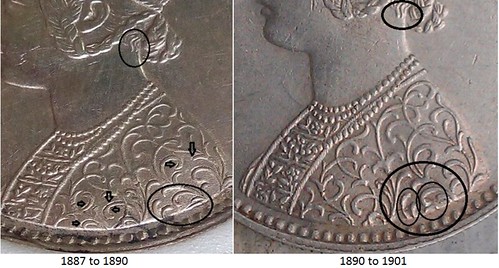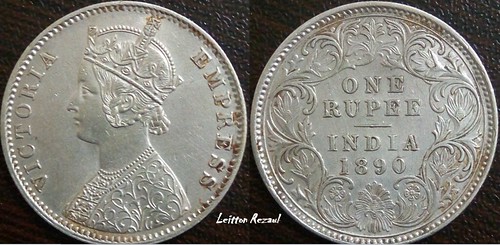
PREV ARTICLE
NEXT ARTICLE
FULL ISSUE
PREV FULL ISSUE
NEW VICTORIA BRITISH INDIAN COINAGE DIE VARIETIESLeitton Rezaul of Bangladesh is a collector and researcher on British Indian Coinage. He submitted this article on a new die variety he's discovered. Thank you. -Editor
New Die Varieties in Queen Victoria Coins of British Indian Coinage In British Indian Coinage we can see many Obverse varieties in Victoria Queens’s period (1862 to 1876). For example A, B, C, D, but in Empress Period (1877 to 1901) we can see only two Obverse A and C. However both A and C Obverse has some sub verity. For example A1, A2, A3, A4, A5, A6, A7, C1, C2, C3, C4, C5 etc. The interesting thing is, those sub variety has few more variety with little changes in Obverse design. For example, C2 (i), C2 (ii), C2 (iii) etc. Here I would like to describe a NEW variety. In the Empress period of British Indian coinage the C3 bust was used by the Calcutta mint (except some mules), and mostly it’s identified by the number of pearls of the queen’s necklace in the second loop and the two extended hairs at the nape of queen’s neck. The C3 bust was first introduced in 1887, and the Calcutta mint was used this bust from 1887 to 1890. But in 1890 the Calcutta mint introduced a new C3 bust with some changes on the Queen’s blouse design and created a new C3 bust variety which we can call C3 (a) or C3 (i). The below images are marked with those changes in blouse design.  Both C3 busts have two extended hairs at the nape of the queen’s neck and the same 10 pearls of the queen’s necklace in the second loop. But the left C3 bust has an incused effect (which marked by the arrow sign) in the flower design of the queen’s blouse which was struck from 1887 to 1890 and the right C3 bust has a raised effect in the flower design of the queen’s blouse which was struck from 1890 to 1901 and there are some changes in flower design also which we can see in the circle marked area of both images. In 1890 the Calcutta mint used both C3 and C3 (a) or C3 (i) dies for struck rupee coins; most probably the mint authority used this new variety on a trial basis in this year and that’s why few specimens of C3 (a) or C3 (i) exist in 1890 rupee coins. In 1891 the Calcutta mint stopped using the old C3 die and started using the new dies C3 (a) or C3 (i) till 1901 except for some mules. Below are images of both varieties in the same Calcutta mint of 1890. Both varieties are in my personal collection.  Obverse with old C3 bust  Obverse with new C3 (i) bust REFERENCES: 2. Standard Catalogue of Coins of British India 1835 to 1947 Currency Issues Authors - Gev Kias and Dilip Rajgor.  Wayne Homren, Editor The Numismatic Bibliomania Society is a non-profit organization promoting numismatic literature. See our web site at coinbooks.org. To submit items for publication in The E-Sylum, write to the Editor at this address: whomren@gmail.com To subscribe go to: https://my.binhost.com/lists/listinfo/esylum All Rights Reserved. NBS Home Page Contact the NBS webmaster 
|